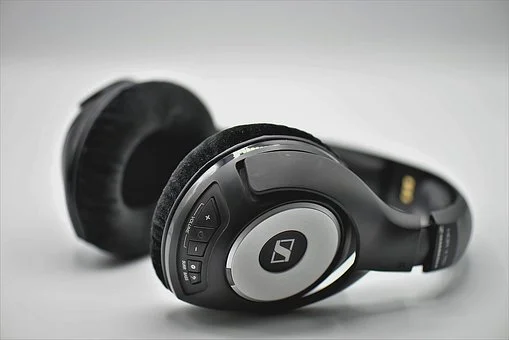I knew that my 2 year old son had auditory sensory processing disorder when I took him to the barber shop. It was just after the nationwide lockdown due to the COVID 19 pandemic.
We had been home for at least 3 months.
The shopping center was awash with activities.
Cars hooting, welding machines making their noise, people haggling over prices.
He started crying holding his ears.
It seemed as though he was in pain. Real pain.
I tried to comfort him but he would not have any of it.
Later reading on the problem, I realized that the auditory stimulations at the shopping center was just too much for him.
So going out, I would need to get him some headphones that would help muffle out the overwhelming noise.
And thus my search for a good pair of noise cancelling earmuffs began.
Best of the Best: Master & Dynamic Wireless active noise-canceling headphones
The Master and Dynamic MW65 is what really saved the day for me and my son. Coming with its Bluetooth adaptability, active noise cancellation (ANC) technology, soft padding and low clamping force, the sensory over-ear headphones are a good fit that reduce noise while at the same time look hip and cool.
It utilizes an active noise cancellation technology while at the same time muffling noise using the seals over his ears.
Comparison Table for Active Noise Cancelling Headphones
Top Earmuffs for Autism
We bought and tried a good deal of noise reduction headphones for autism and came to the conclusion that the following are undoubtedly the best and most effective that money can buy| Headphone Name | Picture | NRR (Noise reduction Rating) | Soft Padding | Weight | Adjustable to fit | Action |
|---|---|---|---|---|---|---|
| Mpow 035 Noise reduction Headphone | 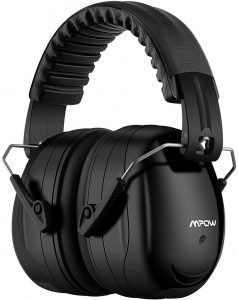 | 28 | Yes | Lightweight | Best fit for kids and adults | Buy on Amazon |
| Anker Soundcore Earmuffs | 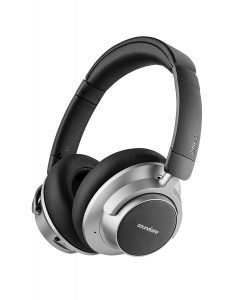 | 12.4 | Yes | Lightweight | Best fits for teenagers and young adults | Buy on Amazon |
| Decibel Defense | 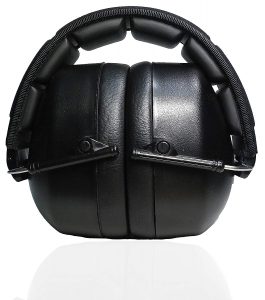 | 37 | Yes | Lightweight | Best fit for big children and adults | Buy on Amazon |
| Fun and Function | 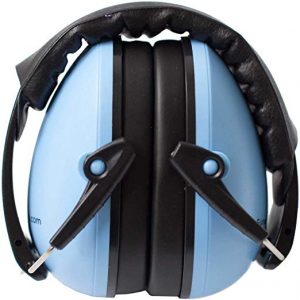 | 20 | Yes | Lightweight | Can fit babies as well as small adults | Buy on Amazon |
| Safety Works | 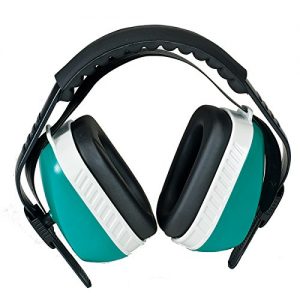 | 24 | Yes | Lightweight | Can fit babies as well as small adults | Buy on Amazon |
| 3M folding | 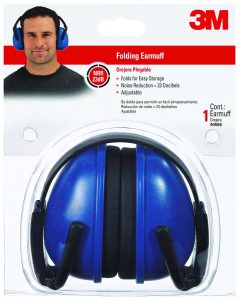 | 23 | Yes | Lightweight | Can fit babies as well as small adults | Buy on Amazon |
Best Budget Noise Reduction Headphones
I highly recommend the Mpow noise reduction earmuffs as the best budget noise-reducing headphones for kids with sensory processing disorder since they are comfortable, have soft padding and have an NRR of 28 decibels. They are not the fanciest and just serve one purpose; to muffle out sounds through the seals over your child’s ears.
Comparison Table for Noise Reducing Headphones that Use Seal to Muffle Noise
Due to over-responsiveness to stimuli, they usually have a reaction called ‘fight, fright or flight’ where the individual just thinks of ways to escape from the too much noise. This could be seen when the person tries to block their ears so that they do not have to be over stimulated by the noise, they create a ruckus as they try to run away and fight off whoever is preventing them from doing so. Because of this need, we are today going to look at the best noise cancelling headphones for autism.
In our review, we look at the effectiveness of the headphones in eliminating background noise, the decibels of noise that is reduced by the headphones (which ideally should be between 20 to 26 dbs), ability to still hear conversations near you as well as the durability of the headphones. Design as well as comfort are also key when investing in the best headphones for autistics.
However when buying noise cancelling devices, you need to consider the environment of your child as well as where they are going to be wearing the noise cancelling headphones at. You do not want them to wear these devices if they are going to cross the road and fail to hear as cars honk them off the road or when their names are called out, sirens are blaring since this could lead to accidents. Some of the places where the child can wear these headphones include:
–In the school cafeteria
–Movie theater
–Restaurants
–School bus
–Shopping mall
–Concerts
Other than headphones which are not at all discrete, one can also use noise reduction earbuds that are more discrete so that you can eliminate noise in rowdy places without people noticing that you are wearing anything.
What to look out for when buying your noise cancelling/reduction headphones for sensory processing disorders

-
Noise reduction as opposed to noise cancelling
While most people are looking for noise cancelling headphones, I greatly oppose this as it might cause safety issues. Noise cancelling or blocking headphones cut out all the sounds from the exterior environment. You really do not want this as your child might not hear the honking of cars, fire alarms or their name being called out. You would rather go for a noise reduction gadget with a good NRR that muffles the unwanted sounds.
-
Padded headband
Your headband needs to be padded for extra comfort to your child.
-
Earmuffs that do not go into the ear
Kids with autism or sensory processing disorder would not want earphones that go into their ears as this could cause a lot of discomfort. The best alternative therefore would be earmuffs that go over the ears without really going in.
-
Noise reduction rating in terms of decibels
A good noise reduction rating in terms of decibels or what is popularly abbreviated as NRR is 20-26.
-
Proper clamping force
Most of the headphones sold online come with a foldable design for saving on space. You will find that as you unfold and place it over the ears, there is a clamping force that the headphones have. You need to make sure that this clamping force is not too much as to injure or cause discomfort in your child.
-
Soft design with no hard edges or corners
Since this will be a gadget that will mostly be used by kids, you want it to be as safe as possible. It is therefore important to check that the edges and corners have a soft design that will not end up bruising or cutting into the tender skin of your child.
Noise Reducing Sensory Headphones for Autistics
So without wasting time, let us delve into our gadgets.
1. Decibel Defense

As the name suggests, these headphones defend your ears from the high decibel noise and deafening volume of blaring music in school parties. They come in different colors and the design too is well accentuated making them a great gift item for autistic teenagers. Their head size is adjustable so they will fit you no matter whether you have a big or small head.
What we Loved about the Decibel Defense headphones
- Wide range of colors
- Great for teenagers owing to the awesome design and wide range of colors
- Effective in cancelling out noise while still making it possible for you to have meaningful conversations with someone near you.
- Good for autistic people who still want to maintain focus despite being in a noisy place that would otherwise distract them.
What we did not like about the Decibel Defense headphones
- One of my autistic students found them to be too tight and the plastic actually tore his ear skin while he was trying to remove them.
2. Fun and Function Noise Reduction Headphones

One thing that I love about Fun and Function company is that they always produce quality products that are suited for children with sensory processing disorder. And so when I learnt that they stock noise reduction headphones, I had to have a look at them so as to know whether they are of high quality as well as effective. And the truth is that Fun and Function, as always, did not disappoint me.
The product does a great job in muffling unwanted background noises so that your kid can concentrate with the task at hand without having to hold their ears in irritation. They are durable and therefore you get true value for your money when you invest in this headset. The Fun and Function headset would be perfect for noisy environments such as when your kid is going to the grocery store, movie theater or restaurant and they want to muffle all the unwanted noise away.
What I loved about the Fun and Function Noise Reduction headphones
- Effective in muffling unwanted sounds
- Durable
- Quality design
- Easily portable since they are light in weight.
What I did not like about them
- Rather stiff to get your head into.

3. NoiseLESS Earphones
One great thing about the NoiseLESS earphones is that they will reduce external noise by 26 decibels. The plastic outer cover is easily adjustable and will comfortably go round the head of a child without compromising on their comfort. The adjustable cups will comfortably cover the ears of your young one to the maximum so that the headphones completely muffle any unwanted outside noise that might interfere with the focus and concentration of the child. The APS plastic material can also be easily cleaned and is highly durable so you do not have to worry about feeling ripped off when you buy this headset.
Key features of the NoiseLESS Earphones
- Adjustable cups
- Noise reduction by 26 decibels
- Maximum cover on the child’s ears therefore a good fit for autism
- Easy to clean APS plastic material
4. Safety Works Super Soft Earmuffs

As the name suggests, the earbuds are super soft and will therefore be a great fit for your child who wants to muffle any unwanted noise so that they can avoid distractions and auditory senses overload. They have a proven noise reduction rate of 24 decibels, adjustable cups as well as a cushioned headband for extra comfort.
5. 3M Folding Earmuffs
The 3M folding earmuffs are foldable to occupy a small space and once unfolded, will provide a custom fit for your autistic child who wants some noise reduction. With a noise reduction rating of 23 decibels, you are assured that your child will be comfortable and will not get a meltdown due to too much auditory senses overload.
6. Mpow 035 Noise Reduction Headphones
When you are looking for headphones that will help reduce noise say when you are shooting, are autistic with sensory overload, want to concentrate in noisy places, then the Mpow 035 noise cancelling headphones should be something that you give much thought to. Specifically designed for hunters as well as archery, the Mpow earplugs have a noise reduction rating of 28 decibels which is an all-time high uniquely designed for people who might lose their hearing ability were they to shoot or hunt without protecting their eardrums.
Kids facing sensory processing disorder would also benefit from this Mpow though I feel that the 28 decibel NRR might be a little too much. You see when you are having a kid who needs noise reduction, you should see that the NRR is only between 20 to 26 decibels. Above 26 is a little too much and the kid might be completely cut out from the background noise which is not very advisable. They need to still hear when cars are beeping or when the teacher calls them out.
What we loved about the Mpow 035 headphones
- Soft padding and headband would be comfy for yourself or even your kid
- Large earplugs work to make sure no noise gets to the kid wearing them
- Comes with a carrying bag and is therefore a good one for when you are travelling.
What we did not like about it
- High NRR rating could make your kid not hear necessary noise that they need to hear. Unless you live in a very noisy place, that 28NRR is too much and could completely muffle sounds so that your kid will not hear when you are calling them or when spoken to.

Autism and auditory sensory processing disorders
The fact that kids with autism have audio sensory disorders can be traced back to the kids who were first diagnosed with autism spectrum disorder by Dr. Kanner. In his article published in 1943, the American psychiatrist says that Donald was petrified of the vacuum cleaner. Elaine would not want to be close to the closet where the vacuum cleaner was placed.
Studies show over 90 percent of people diagnosed with autism either overreact or ignore audio sensations. People with ASD have problems filtering out irrelevant sensory inputs such as sights, sounds, touches and smells.
Key Features in active noise cancelling headphones
Below are some factors that you need to consider when buying your set of active noise cancelling (ANC) headphones. They include:
- Impedance and sensitivity
- Noise reduction rating vs active noise cancellation
- Over-ear vs on-ear vs in-ear
- Battery life
- Wired vs wireless headphones
Battery life
The battery life that is usually labeled on your headphone is at most times inaccurate. If you find that the manufacturer claims that a certain headphone can play music for up to 30 hours without the need for a recharge, you will find that your set of headphones do not live up to this. It is not like the manufacturers are fibbing or anything but they tested the set of headphones on low-volume music. But here you are playing full blast. The same headphone that was labeled as going for 30 hours might only go for 20 hours.
Even with all this noise, inaccuracies by the manufacturer and their little fibs, it is still worth comparing the battery life so that you can go with the one with the highest battery life label.
Impedance and sensitivity
Headphone impedance is a much-debated topic among audiophiles who want excellent sound quality playing in their ears. While it might not be a big consideration when buying noise-canceling headphones for your autistic kid, it is still worth worrying about. Impedance is simply the electrical resistance that the headphone has to put up with so that it can play. It is usually labeled as 8 -600ohms. When you are playing music from a smartphone, you would want an impedance rating that is no bigger than 32 ohms. If it is above 33ohms that is too great of an impedance and your smartphone lacks the power to play in your headphones.
Headphone sensitivity shows how much volume your headphones can have at low power. A headphone with high sensitivity will be easily heard even when there is little power supplied to it.
Noise reduction rating (NRR) vs Active noise cancellation (ANC)
Noise isolation is a big thing for people with ASD or generally people with sensory processing disorders.
Noise reduction rating (NRR)
The traditional noise-canceling headphones muffle out noise by having a seal that pad your ear canal from outside noise. They usually have a noise reduction rating (NRR) that shows how much noise is reduced. The Mpow 035 safety ear muffs for example have an NRR of 28 decibels meaning that their paddings are able to muffle out only 28 decibels of noise from the outside. If the outside noise is 88 decibels, then 60 decibels are still going to reach your ears.
Active noise cancellation (ANC)
Another mode of muffling outside noise is the more sophisticated active noise cancellation that is available in more premium headphones. It cancels out noise by introducing another ambient noise.
To understand how the ANC headphones work, picture outside noise to be a sound wave(because that is what it is) with troughs and crests. The ANC headphone produces opposite sound waves so that where there was a trough in the outside noise is met by a crest in the ambient sound and vice versa. This way, the two sound waves when superimposed together are able to cancel out each other.
They have a microphone that traps the outside noise and then produces a phase-reversed sound that is fed into tiny speakers in your set of headphones.
It sounds easy and doable in theory but in practice, you find that even the best ANC headphones are not really able to cancel out high-frequency sounds. The New York Times has published an article that reports that ANC headphones are not really able to cancel out human voices, baby crying or a door being bang shut. The best they can do is muffle and reduce the noise but not completely shut it out.
ANC headphones require batteries for them to work.
Wired vs wireless
A few years ago, wired headphones were very common. Today, they are no longer in vogue. In fact, most people are doing wireless headphones that they can connect to their devices by Bluetooth, Google Assistant, Alexa or even Siri.
For a child with autism, you would want a headphone that causes the least of disturbances. A wired headphone with all those loosely hanging wireless could easily get tangled and irritate your child. At the same time, they will be bugged down by the weight of their smartphone or iPod which they have to carry along so that to listen to the wired music.
Though wired headphones might have a better sound quality, they are not really worth it.
Wireless is the way to go.
The only downside with wireless headphones is that their use of Bluetooth connectivity might create an interference with your Wifi since they use the same range of frequency.
Over-ear vs on-ear vs in-ear headphones
Over-ear headphones are structured such that they will cover the entire ear going over it. They have soft padding and you are able to getter better sound quality while muffling out all the outside noise. The muffling could be done through the use of ANC if the headphones have a battery coupled with NRR which is guaranteed thanks to the thick padding over your ears.
The challenge comes in when you try to exercise with this set since sweat will be trapped within your ear. This would really irritate an autistic person. They also tend to be weighty and so you would have to be careful before putting them over your kid.
Another flaw about the constant use of over-ear headphones is that it can cause an eardrum suck that eventually leads to headaches. An eardrum suck is a reduction of air pressure in your eardrums which can feel really bad especially for kids. It is the same feeling that one gets when using a high-speed elevator in a tall building.
On-ear headphones cover just the outer part of the ear without going over the lobes. While they do not have sound quality as excellent as the over-ear set and are not really good at canceling outside noise, they are still comfortable and great for when walking on the streets.
In-ear buds on the other hand go inside the ear. They are not comfortable and have poor noise-canceling ability, not unless they use ANC noise muffling technology.
